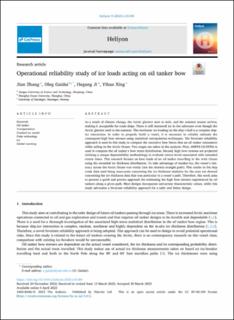| dc.contributor.author | Zhang, Jian | |
| dc.contributor.author | Gaidai, Oleg | |
| dc.contributor.author | Ji, Hegang | |
| dc.contributor.author | Xing, Yihan | |
| dc.date.accessioned | 2023-09-08T11:40:11Z | |
| dc.date.available | 2023-09-08T11:40:11Z | |
| dc.date.created | 2023-04-13T10:58:02Z | |
| dc.date.issued | 2023-04 | |
| dc.identifier.citation | Zhang, J., Gaidai, O., Ji, H. & Xing, J. (2023) Operational reliability study of ice loads acting on oil tanker bow. Heliyon, 9(4): e15189 | en_US |
| dc.identifier.issn | 2405-8440 | |
| dc.identifier.uri | https://hdl.handle.net/11250/3088294 | |
| dc.description.abstract | As a result of climate change, the Arctic glaciers start to melt, and the summer season arrives, making it acceptable for trade ships. There is still shattered ice in the saltwater even though the Arctic glaciers melt in the summer. The stochastic ice loading on the ship's hull is a complex ship-ice interaction. In order to properly build a vessel, it is necessary to reliably estimate the consequent high bow stresses using statistical extrapolation techniques. The bivariate reliability approach is used in this study to compute the excessive bow forces that an oil tanker encounters while sailing in the Arctic Ocean. Two stages are taken in the analysis. First, ANSYS/LS-DYNA is used to compute the oil tanker's bow stress distribution. Second, high bow stresses are projected utilizing a unique dependability methodology to evaluate return levels associated with extended return times. This research focuses on bow loads of an oil tanker travelling in the Artic Ocean using the recorded ice thickness distribution. To take advantage of weaker ice, the vessel's itinerary across the Arctic Ocean was windy (not the shortest straight path). This results in the ship route data used being inaccurate concerning the ice thickness statistics for the area yet skewed concerning the ice thickness data that was particular to a vessel's path. Therefore, this work aims to present a quick and precise approach for estimating the high bow stresses experienced by oil tankers along a given path. Most designs incorporate univariate characteristic values, while this study advocates a bivariate reliability approach for a safer and better design. | en_US |
| dc.language.iso | eng | en_US |
| dc.publisher | Elsevier Ltd. | en_US |
| dc.rights | Attribution-NonCommercial-NoDerivatives 4.0 Internasjonal | * |
| dc.rights.uri | http://creativecommons.org/licenses/by-nc-nd/4.0/deed.no | * |
| dc.subject | konstruksjoner og materialer | en_US |
| dc.subject | tankskip | en_US |
| dc.subject | Arktis | en_US |
| dc.subject | polar teknologi | en_US |
| dc.subject | sjøis | en_US |
| dc.subject | global oppvarming | en_US |
| dc.title | Operational reliability study of ice loads acting on oil tanker bow | en_US |
| dc.type | Peer reviewed | en_US |
| dc.type | Journal article | en_US |
| dc.description.version | publishedVersion | en_US |
| dc.rights.holder | © 2023 The Author(s). | en_US |
| dc.subject.nsi | VDP::Teknologi: 500::Bygningsfag: 530::Konstruksjonsteknologi: 533 | en_US |
| dc.source.volume | 9 | en_US |
| dc.source.journal | Heliyon | en_US |
| dc.source.issue | 4 | en_US |
| dc.identifier.doi | 10.1016/j.heliyon.2023.e15189 | |
| dc.identifier.cristin | 2140525 | |
| dc.source.articlenumber | e15189 | en_US |
| cristin.ispublished | true | |
| cristin.fulltext | original | |
| cristin.qualitycode | 1 | |

